Comments / Questions (121)
![]() Gilda Groothuis wrote:
Gilda Groothuis wrote:
Kan ik het patroon uit printen ?
11.03.2025 - 09:22
![]() TylerRuito wrote:
TylerRuito wrote:
Equilibrado Sistemas de calibración: clave para el funcionamiento uniforme y eficiente de las máquinas. En el campo de la tecnología contemporánea, donde la productividad y la fiabilidad del aparato son de gran relevancia, los equipos de ajuste desempeñan un tarea esencial. Estos dispositivos dedicados están diseñados para ajustar y estabilizar piezas giratorias, ya sea en herramientas de fábrica, vehículos
26.01.2025 - 03:26
![]() NormanEmicy wrote:
NormanEmicy wrote:
Kantor bola 99
25.12.2024 - 02:30
![]() Walternet wrote:
Walternet wrote:
Explore CS2 Skin Discover the Collection of CS2 Skins: Pick the Ideal Design for Your Game Experience Upgrade your gameplay with one-of-a-kind, high-quality designs that enhance the design of your arsenal and make your gear truly be unique. We offer a huge range of items — from exclusive items to exclusive options, enabling you the opportunity to customize your equipment and display your preferences. Why Trust Us? Buying CS2 skins in our store
14.12.2024 - 21:30
![]() JeffreyCoove wrote:
JeffreyCoove wrote:
E-file manicure Austin
18.11.2024 - 16:23
![]() Aaronzem wrote:
Aaronzem wrote:
Ovo-jp ovo-jp
10.10.2024 - 17:17
![]() Cecilie wrote:
Cecilie wrote:
Jeg får ikke færre masker på ærmerne ved raglan. Strikker 3m sammen både før og efter A2, som der står i opskriften. Der bliver færre på både ryg og forstykket men ikke ærmerne. Hvad går der galt?
12.09.2024 - 15:59DROPS Design answered:
Hei Cecilie. Usikker på hvor det blir feil hos deg, men fra retten strikk 2 stolpem, x antall m til det gjenstår 3 m før A.2, strikk 3 m rett sammen (= 2 felte m). Strikk A.2. Strikk 3 m sammen, strikk x antall m til det gjenstår 3 m av høyre erme og strikk 3 m rett sammen (= 4 felte m på høyre erme). Strikk A.2. Strikk 3 m sammen, glstrikk og A.1 som før og strikk de 3 siste m sammen (før A.2). Det er nå felt 4 m av ryggen. Strikk A.2. Fell og strikk som høyre erme (= 4 felte m på venstre erme). Strikk A.2. Strikk 3 m sammen, x antall og 2 stolpem. Det er nå felt 16 m, men det er også laget 1 kast på hver side av A.2. mvh DROPS Design
16.09.2024 - 11:59
![]() Cecilie wrote:
Cecilie wrote:
Jeg får ikke færre masker på ærmerne ved raglan. Strikker 3m sammen både før og efter A2, som der står i opskriften. Der bliver færre på både ryg og forstykket men ikke ærmerne. Hvad går der galt?
12.09.2024 - 15:58
![]() Bretttof wrote:
Bretttof wrote:
Slot853 login
11.09.2024 - 04:19
![]() RaymondMup wrote:
RaymondMup wrote:
Risk Mitigation Procedures - it a crucial tool used by companies and commercial entities to ensure the confirmation they are not interacting with separate citizens or companies involved in criminal operations. Such algorithm covers confirming the data of buyers by means of numerous records, such as sanctions inventories, high-level officials (PEP) lists and additional control lists. Within the realm of cryptocurrencies, Anti-Money Laundering screening instruments facilitate identif
24.08.2024 - 05:10
Diamonds And Pearls#diamondsandpearlscardigan |
||||||||||||||||||||||||||||||||||
 |
 |
|||||||||||||||||||||||||||||||||
Knitted DROPS bolero with lace pattern and raglan "BabyAlpaca Silk", "Kid-Silk" and "Glitter". Size: S - XXXL.
DROPS 157-12 |
||||||||||||||||||||||||||||||||||
|
GARTER ST (back and forth on needle): K all rows. 1 ridge = K2 rows. GARTER ST (in the round on double pointed needles): * K 1 round and P 1 round *, repeat from *-*. 1 ridge = 2 rounds. PATTERN: See diagrams A.1-A.2. The diagrams show all rows in pattern seen from RS. When dec for raglan, dec in sts in pattern A.1. NOTE: Do not work YOs twisted, they should make holes. INCREASE TIP 1 (applies to mid front) All inc are done from RS. Inc 1 st by making 1 YO, on next row P YO twisted (i.e. work in back loop of st instead front) to avoid holes. INCREASE TIP 2 (applies to inc in the sides + sleeves) All inc are done from RS. Inc 1 st by making 1 YO before marker, K 1, 1 YO (= 1 st inc on each side of marker). On next row/round K/P YOs twisted to avoid holes. DECREASE TIP 1 (applies to raglan dec): Dec 1 st before A.2 as follows: Work until 3 sts remain before A.2, K 3 tog (i.e. 1 st for raglan and 1 st for YO in A.2 has been dec). Dec 1 st after A.2 as follows: K 3 twisted tog (i.e. 1 st for raglan and 1 st for YO in A.2 has been dec). Dec 2 sts before A.2 as follows: Work until 4 sts remain before A.2, K 4 tog (i.e. 2 sts for raglan and 1 st for YO in A.2 have been dec). Dec 2 st after A.2 as follows: K 4 twisted tog (i.e. 2 st for raglan and 1 st for YO in A.2 has been dec). DECREASE TIP 2 (applies to neck dec): Dec inside 2 band sts in each side. All dec are done from RS! Dec after 2 band sts as follows: Slip 1 st as if to K, K 1, psso. Dec as follows before 2 band sts: K 2 tog. BUTTONHOLES: Dec for buttonholes on right band. 1 buttonhole = K tog third and fourth st from edge and make 1 YO. Dec for buttonholes when piece measures (measured from cast-on edge): SIZE S: 7, 13 and 19 cm / 2¾",5",7½" SIZE M: 8, 14 and 20 cm / 3",5½",8" SIZE L: 7, 14 and 21 cm / 2¾",5½",8¼" SIZE XL: 8, 15 and 22 cm / 3",6",8¾" SIZE XXL: 7, 15 and 23 cm / 2¾",6",9" SIZE XXXL: 8, 16 and 24 cm / 3",6¼",9½" ---------------------------------------------------------- BODY: Worked back and forth on circular needle to make room for all the sts. Cast on 105-117-129-149-169-189 sts on circular needle size 5 mm / US 8 with 1 strand of each yarn (= 3 strands). Work 1 ridge in GARTER ST - see explanation above. P 1 row from WS with 2 edge sts in garter st in each side of piece. Then work as follows from RS: 2 sts in garter st (= band sts), 21-24-27-32-37-42 sts in stockinette st (= right front piece), insert 1 marker, 1-4-7-12-17-22 sts in stockinette st, A.1 (= 57), 1-4-7-12-17-22 sts in stockinette st (= back piece), insert 1 marker, 21-24-27-32-37-42 in stockinette st, finish with 2 sts in garter st (= band sts). Work band sts in garter st until finished measurements. Work 2 rows in garter st, stockinette st and A.1. REMEMBER THE GAUGE! READ ALL OF THE FOLLOWING SECTION BEFORE CONTINUING! INC MID FRONT AND IN THE SIDES AT THE SAME TIME AS FOLLOWS: INC MID FRONT: Inc 1 st in each side of piece inside 2 band sts - READ INCREASE TIP 1. Repeat inc every row from RS 7 more times. Work inc sts in stockinette st. Remember BUTTONHOLES - see explanation above. INC IN THE SIDES: When piece measures 3-3-4-4-5-5 cm / 1⅛"-1⅛"-1½"-1½"-2"-2", inc 1 st on each side of markers (= 4 sts inc) – see INCREASE TIP 2. Repeat inc every 3 cm / 1" 4 more times. Work inc sts in stockinette st. When all inc are done there are 141-153-165-185-205-225 sts. Continue in garter st, stockinette st and A.1 until piece measures 17-18-19-20-21-22 cm / 6¾"-7"-7½"-8"-8¼"-8¾". Then bind off 3 sts on each side of each marker for sleeve = 129-141-153-173-193-213 sts (= 33-36-39-44-49-54 sts on each front piece and 63-69-75-85-95-105 sts on back piece). Insert 1 marker in each side of piece in band sts mid front. Work an edge in garter st later between markers. Put piece aside and knit the sleeves. SLEEVE: Worked in the round on double pointed needles. Cast on 32-34-36-38-40-42 sts on double pointed needles size 5 mm / US 8 with 1 strand of each yarn (= 3 strands). Work 1 ridge in GARTER ST - see explanation above. Insert 1 marker at the beg of the round. Then work piece in stockinette st. When piece measures 11 cm / 4½", inc 1 st on each side of marker - remember INCREASE TIP 2! Repeat inc every 4-4-3½-3-2½-2½ cm / 1½"-1½"-1¼"-1"-⅞"-⅞" 6-6-7-8-9-9 more times. Switch to circular needle when needed. Then inc 1 st on each side of marker every round 13 times in total = 72-74-78-82-86-88 sts. Work until piece measures 45-45-44½-44½-44-44 cm / 17¾"-17¾"-17½"-17½"-17¼"-17¼". Then bind off 6 sts mid under sleeve (i.e. Bind off 3 sts on each side of marker) = 66-68-72-76-80-82 sts. Put piece aside and make another sleeve. YOKE: Slip sleeves on to same circular needle as body where armholes were bind off = 261-277-297-325-353-377 sts. Work as follows from WS: Work 2 sts in garter st (= band sts), 31-34-37-42-47-52 sts in stockinette st (= left front piece), A.2 (= 2 sts), 62-64-68-72-76-78 sts in stockinette st, A.2 (= left sleeve), stockinette st and A.1 as before over back piece (= 63-69-75-85-95-105 sts), A.2, 62-64-68-72-76-78 sts in stockinette st, A.2 (= right sleeve), 31-34-37-42-47-52 stockinette st, finish with 2 sts in garter st (= band sts). Continue as before in garter st, stockinette st, A.1 and A.2 AT THE SAME TIME dec for raglan – read DECREASE TIP 1. Dec is different on sleeves/back piece and front piece. ON SLEEVE/BACK PIECE: Dec 1 st on every row from RS 21-22-23-24-26-27 times = 24-24-26-28-28-28 sts on each sleeve and 21-25-29-37-43-51 sts on back piece. ON FRONT PIECE: Dec 1 st on every row from RS 19-19-19-16-16-13 times, then 2 sts on every row from RS 2-3-4-8-10-14 times, i.e. on last dec, dec 1 band st. AT THE SAME TIME on 6th row in raglan dec 1 st for neck inside the 2 band sts in garter st in each side of piece – READ DECREASE TIP 2, repeat after 6th row 1 more time, then dec every 4th row 7-7-7-8-9-10 times, then every other row 0-1-2-1-1-0 times. After all dec on front piece 1 band st remains on front piece. On the next 2 rows, bind off the 1 band st and A.2 (= 2 sts) in each side of piece. After all bind off and dec are done, 65-69-77-89-95-103 sts remain on needle. Now work an elevation in the neck as follows: Size S-M-L: Now continue piece in stockinette. Work 1 row over all sts AT THE SAME TIME dec 12-14-18 sts evenly = 53-55-59 sts. Work 26-27-29 sts (= mid back), turn piece. Work 15-16-20 sts, turn piece and work 30-32-40 sts, turn piece. Work 24-26-32 sts, turn piece and work 18-20-24 sts, turn piece. Work 14-15-17 sts, turn piece and work 10 sts. Cut the yarn and slip sts on a stitch holder. Size XL-XXL-XXXL: Continue raglan dec until sts have been slipped on a stitch holder (i.e. dec 1 st on each side of A.2 where it is possible). AT THE SAME TIME work an elevation as follows: * Work the first 6 sts, then slip them on a stitch holder and work the rest of the row. Do the same in the opposite side of the piece *, repeat from *-* 2 more times. Cut the yarn and slip the remaining sts on a stitch holder. Then pick up approx. 60-90 sts (includes sts from stitch holder) between markers on body. Work 1 ridge AT THE SAME TIME on 1st row adjust no of sts to 60-62-70-74-82-82. Bind off. EDGE: Crochet edge around front piece, the neck and in bottom edge of back piece and in sleeve edge on hook size 5 mm / H/8 with 1 strand Kid-Silk. Work 1 sc, * ch 3, skip 1 st/row, 1 sc in outer loop of outermost next st/row *, repeat from *-* around opening. Finish with 1 sl st in first sc. Fasten off. ASSEMBLY: Sew tog under sleeves. Sew the buttons on to left front piece. |
||||||||||||||||||||||||||||||||||
Diagram explanations |
||||||||||||||||||||||||||||||||||
|
||||||||||||||||||||||||||||||||||
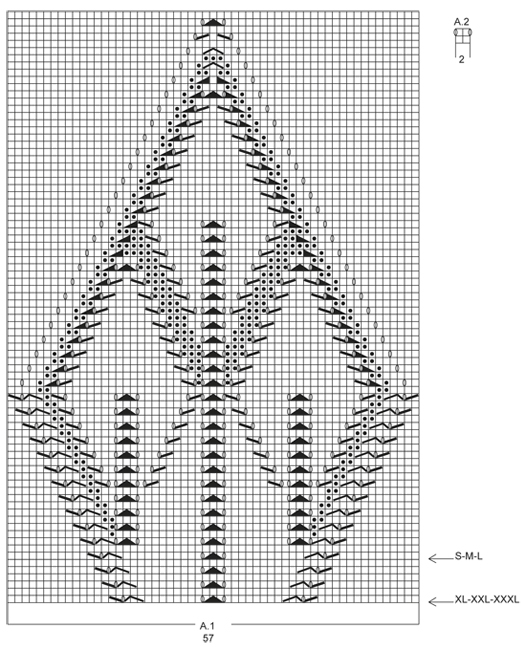 |
||||||||||||||||||||||||||||||||||
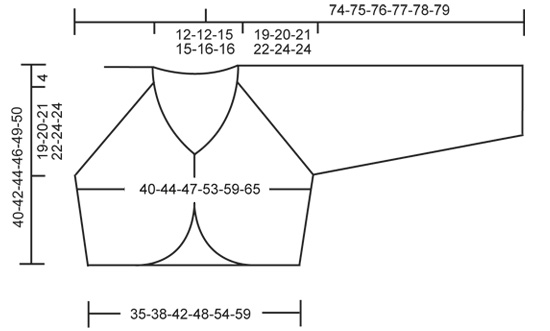 |
||||||||||||||||||||||||||||||||||
Have you finished this pattern?Tag your pictures with #dropspattern #diamondsandpearlscardigan or submit them to the #dropsfan gallery. Do you need help with this pattern?You'll find 34 tutorial videos, a Comments/Questions area and more by visiting the pattern on garnstudio.com. © 1982-2025 DROPS Design A/S. We reserve all rights. This document, including all its sub-sections, has copyrights. Read more about what you can do with our patterns at the bottom of each pattern on our site. |
||||||||||||||||||||||||||||||||||







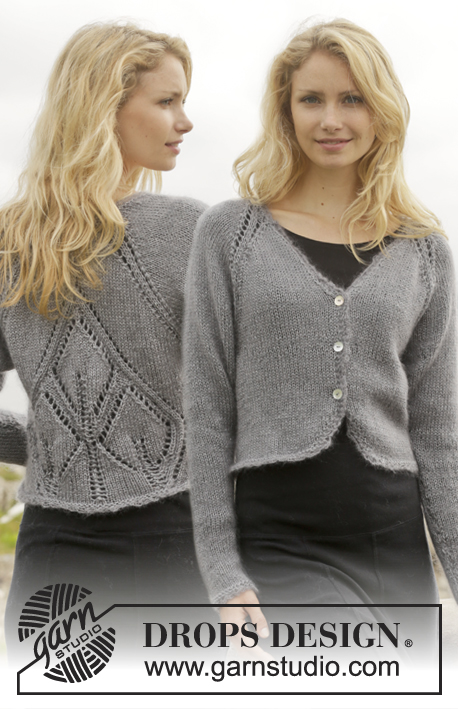


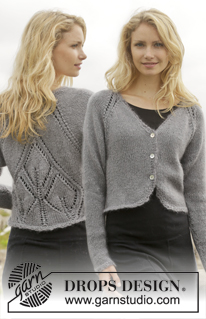








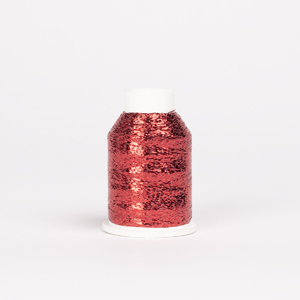




























































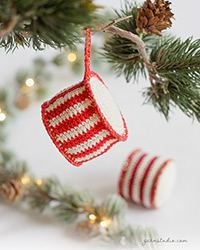
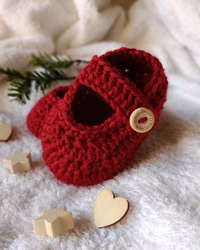
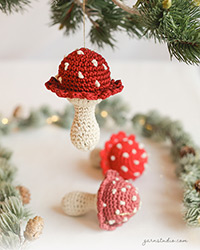
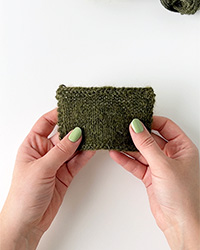

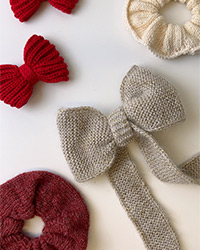
Post a comment to pattern DROPS 157-12
We would love to hear what you have to say about this pattern!
If you want to leave a question, please make sure you select the correct category in the form below, to speed up the answering process. Required fields are marked *.